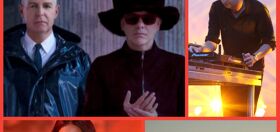
AIDS is the great equalizer. Young, old, black, white, gay, straight, transgendered, Christian, Muslim – you name a social group, most likely a member has HIV/AIDS.
Not since the Black Plague has a disease so dramatically altered the course of history. We’re all touched by HIV/AIDS, even if we don’t realize it. Thus, it’s imperative that we all play a role in the protracted nightmare – a message the AIDS Walk embraces in its new social realism-inspired poster campaign…
Created in 1986 by MZA Events, the AIDS Walk has grown from a 4,500 operation to a four-city 47,000 strong mega-march. Over the past 21 years, the annual event – held in New York, Los Angeles, San Francisco and Fort Lauderdale – has raised over $91,000,000. Though, distributed to a number of 501c3 organizations, most of the dough goes to Gay Men’s Health Crisis, a twenty-five year old organization that knows a thing or two about that nasty retrovirus, HIV.
In the past, MZA and the AIDS Walk organizers have used group photos and semaphore-inspired logos to spread their ambulatory message. This year, however, AIDS Walk creative manager and New York’s event coordinator, Leif Green, wanted something with a little more oomph. “It’s a call to arms,” Green says, tossing reading glasses on his Diet Coke littered desk at GMHC’s New York headquarters:
A lot of people, for whatever reasons, do it one year and then they skip a few and come back, so we’re always trying to send the message, ‘Stay involved or get involved’.
The Walk grows each year, but there’s no such thing as “enough” when it comes to this particular plague.

Green’s quest for a compelling, rebellious image led him to artist agent Jae Wagoner’s virtual digs. Of all Wagoner’s nineteen artistic offerings, one artist in particular caught Green’s eye, Joel Rodgers, particularly the image to the right.
How about we take this to the next level?
Our newsletter is like a refreshing cocktail (or mocktail) of LGBTQ+ entertainment and pop culture, served up with a side of eye-candy.
One of the things that came out of our meeting was that it had to look warm and golden. These were the words that people were using, but nothing was really making a vision in my head. Then one day, I started thinking of horizon… A lot of Joel’s stuff is evocative of the WPA.
The most monolithic of President Franklin D. Roosevelt’s New Deal programs, the Works Progress Administration aimed to both improve American living and create jobs lost during the Great Depression. Most of the projects focused on erecting public buildings, bridges, highways, byways, parks and other civil essentials.
In addition to all this social and economically minded architecture, the WPA also extended a federal hand to artists and writers. Commissioned by the Federal Art Project to illustrate government posters, decorate public buildings and spread visual messages, WPA-era artists were a product of their time. The depression had nearly wiped out all hope. Things were grim in America – and, in fact, everywhere. The world had just begun to emerge from the horrible ash of The Great War: a traumatic resurrection exhibited in one of the predominant artistic movements of the time, social realism.
As one can probably guess, social realism comes from realism, which actively eschewed the idealistic romanticism so popular in the early 1800’s. Artists strove to capture the lived experience. As the movement evolved, realism started to take on a social message, particularly in the Soviet Union. It’s there that the Bolsheviks used the October Revolution to implement a state-sponsored arts program. The state-sponsored realistic product, of course, worked to advance the socialist vision. Incorporating this forward-thinking, goal-oriented ideology, socialist realism found itself informed by the Russian avant-garde, including cubo-futurism, an aesthetic concerned with speed, industry and, yes, progress. Perhaps it’s for this reason that the Works Progress Administration became the Works Project Administration…

A little over a decade after the Bolsheviks used art to fuel their forward motion, so, too did the United States government. The world had its eye on the future. And so did some power hungry international leaders. Less than a decade after the launch of the WPA, the United States got the reliable World War boom and shut the project down. Social realism may have lost federal backing and artistic demand, but the message remains the same. Green continues to laud Rodgers’ WPA-inspired style:
It matched the things that we wanted: we have the horizon there, we have activism… It invokes “I’m going to take a stand. I’m fighting back!”
AIDS fundraising isn’t simply about the ever-important dollar. Despite the fact that anyone and everyone can catch the bug, HIV remains a political disease.
Green asserts:
I think AIDS will always be political because of the way it’s transmitted. The primary modes of transportation of the virus are sexually and intravenously, so people are always going to be reluctant to talk about that.
Originally referred to as Gay-related Immunodeficiency, HIV has never managed to shed the social taboo. Gays, drug addicts and other “morally corrupt” groups take a lot of the anti-AIDS heat.
The AIDS Walk poster campaign hopes to shake those connotations:
We did six different versions. I couldn’t think of just one person and some people would feel excluded. Each person is an amalgamation of ideas. What’s nice is that when I talk to people they see themselves in it.
Four of the six images feature solitary figures. The remaining two depict a woman with a child and a gay couple, respectively. Green explains that the maternal image sprang as much from a need to domesticate the disease as from his office’s proximity to GMHC’s child care center.

He goes on to explain that the gay couple was non-negotiable:
An AIDS Walk has to include the gay community and you have to be clear about it. My only regret was that we couldn’t do the same thing with two women… AIDS will always be a part of the gay community and I feel that it’s a part of my job to make sure that that connection stays intact.
When asked how he would respond to contenders asserting homosexuality’s divisive nature, Green remarks, “I’m not willing, as a gay man who has been working on the AIDS Walk since its inception, to [exclude them]. ” Nor does the AIDS Walk exclude non-gay organizations.
In addition to GMHC, the AIDS Walk benefits Episcopal Response to AIDS, the food-oriented God’s Love We Deliver, AIDS Project Los Angeles and Keep a Child Alive, which helps HIV-infected babies in Africa. Their campaign perfectly illustrates their mission: individuals coming together to fight a global crisis. No one walker can chart a path to victory. 47,000? That’s a veritable army.
Like all armies, this one’s always taking new recruits. You have until Saturday to register for the AIDS Walk, so hop to it.




















cjc
Great cause. And great art. It makes me want to start busting out the ol’ Anthem of the Soviet Union.